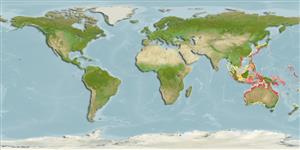Gastropoda |
Neogastropoda |
Turbinellidae
Environment: milieu / climate zone / depth range / distribution range
Ecology
Benthic; depth range 0 - 30 m (Ref. 349). Tropical
Indo-West Pacific: northern and western Australia to Irian Jaya.
Length at first maturity / Size / Weight / Age
Maturity: Lm ? range ? - ? cm Max length : 72.2 cm SHL male/unsexed; (Ref. 99323); common length : 60.0 cm SHL male/unsexed; (Ref. 349)
Traditionally fished for its gigantic shell and edible flesh. Suffered from frequent local over collecting. Deeper populations seem to occur in the northern part of its geographical range (Ref. 349). Occurs in shallow subtidal sand flats. Feeds on sedentary polychaete worms (Ref. 349).
Life cycle and mating behavior
Maturity | Reproduction | Spawning | Eggs | Fecundity | Larvae
This species is a non-broadcast spawner. Life cycle does not include trocophore stage. Also Ref. 833.
Poutiers, J.M. 1998 Gastropods. p. 363-648. In Carpenter, K. E. and V. H. Niem. 1998. FAO species identification guide for fishery purposes. The living marine resources of the Western Central Pacific. Volume 1. Seaweeds, corals, bivalves, and gastropods. Rome, FAO. (Ref. 349)
IUCN Red List Status
(Ref. 130435: Version 2025-1)
CITES status (Ref. 108899)
Not Evaluated
Not Evaluated
Threat to humans
Harmless
Human uses
| FishSource |
Tools
More information
Population dynamicsGrowth
Max. ages / sizes
Length-weight rel.
Length-length rel.
Length-frequencies
Mass conversion
Abundance
PhysiologyOxygen consumption
Human RelatedStamps, coins, misc.
Internet sources
Estimates based on models
Preferred temperature
(Ref.
115969): 23.6 - 29.3, mean 28.1 (based on 1425 cells).
Fishing Vulnerability
Moderate to high vulnerability (49 of 100).
Price category
Unknown.
